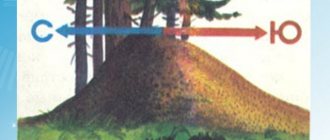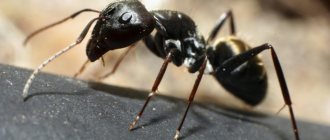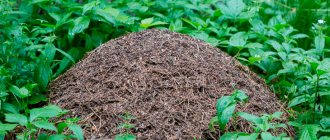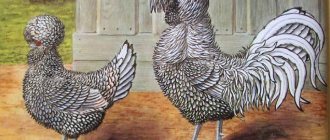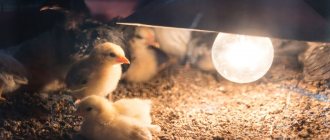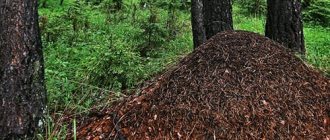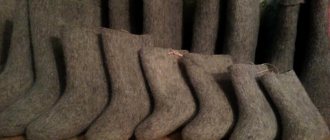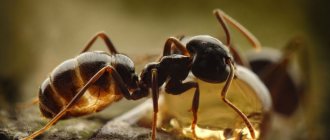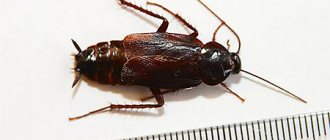- home
- Trips
- Orientation by moss and anthill
libre19 January 2013 66877
In the forest there lies a large stone-boulder, overgrown with fluffy moss on one side. Look carefully at this unusual compass, which was created by nature itself. We have already written about various signs of orienteering, orienteering in the forest and using a compass. We recommend reading these interesting articles.
Where do ants usually build an anthill?
An anthill is an excellent assistant in determining the sides of the horizon. Hardworking ants build their homes near trees on the south side. It turns out to be a fairly reliable guide. Especially in cloudy weather when the sun is not visible. So, how to navigate an anthill?
Ants are poikilothermic insects, meaning their body temperature depends on how hot the surrounding atmosphere is. Therefore, to prepare for the intense day's work, they need to get a good dose of heat. And the sun best warms up the southern part of the dome-shaped dwelling, which is also more flat compared to the part that is directed to the north and may be adjacent to a tree trunk.
Orientation by anthill
The anthill has not only an above-ground part, which hard-working insects collect from pieces of fallen leaves, sticks, needles, and soil particles, but also extensive underground “apartments.” It is there that a large family of ants waits out the unfavorable cold season. But even in winter, clearly visible mounds with a characteristic dome shape adjacent to trees can serve as a fairly reliable landmark in the forest. With some exceptions, which will be discussed below.
Thus, if you know on which side of the tree the ants build their house, then it will not be difficult to correctly navigate and determine the road that will lead where you need it.
Advice! Additional information about the sides of the horizon can be provided by moss growing on a tree near which there is an anthill. It, like lichen, prefers to settle on the north side of tree trunks; using this feature, you can further verify the correctness of your conclusions.
Internal structure of an anthill
The inside of an anthill consists of many passages, corridors, chambers and compartments designed for specific purposes.
The rooms located on the upper levels of the anthill are heated by the sun in the summer and are used as a solarium for adult insects. The main building material for the interior decoration of an ant house is a mixture of soil with humus, particles of bark and everything that worker construction ants bring with them. A large number of passages connecting different rooms provide ventilation in the anthill.
At the middle levels of the ants’ home there are rooms with food storage, storage rooms for collecting garbage, and even an ant cemetery where dead compatriots are brought. The main entrances to the anthill are also located at the middle level, that is, at the foot of the outer hill.
A large space is covered by a special chamber designed for. In the lower layers of the soil they shelter from frost, providing themselves with everything they need during the summer.
Guide to the shape of an anthill
Often the anthill is located in the south direction from a tree, stump, or bush, and this makes it easier to navigate. However, in treeless areas, it will also help determine the choice of the desired direction. It was already mentioned above that the dome of the ants’ home is asymmetrical.
South direction of the anthill
How to determine where north is: the slope facing this direction is steeper than the one facing south. This is due to the fact that a steep slope better protects the building from the effects of the cold north wind, while a gentle slope is warmed up more easily and quickly by the sun.
In any case, both in the forest and in open areas, a more accurate determination of the cardinal directions is ensured by examining not one, but several nearby anthills. You need to mentally draw a longitudinal line through the center of each dome and see in which direction they all go. This way you can more accurately determine the north-south direction, and, consequently, east-west.
Orientation by moss and lichen
Mosses and lichens do not like heat and light, so they grow in the shady side. This means that where there are mosses and lichens, there is north; on the south side there is less or no moss at all. Now orienteering on moss will not present you with any difficulties. You can also determine the direction by looking at the soil around the stone. On one side it is relatively dry (south), and on the opposite side it is wetter (north). Usually an old, rotting stump is overgrown with moss on all sides.
But to determine where north and south are, you need to check the moisture content of the moss, not the soil.
Incorrect anthills for orientation
Is an anthill always an impeccable landmark? Unfortunately no. And this, for the most part, depends on its location. If the ants have built their home on the edge of a dense forest or near a road, then it is better to look for another dome-shaped structure to use as a landmark.
Anthill on the edge of the forest
Note! A family of forest workers always locates their house in the most optimal way in order to more efficiently use solar heat, but in these cases the direction of the main axis of the anthill can be shifted and run from west to east or in the north-west direction. Then you should use other methods. For example, branches facing south grow thicker on trees.
Remember this method yourself and tell your children how to determine the cardinal directions by the location of the anthill, its shape, and other signs, so that if you find yourself in a difficult situation, you can use the information received. It is useful to demonstrate to children visually, with a device in hand, that natural landmarks are indeed quite accurate. You can also use the hour hand of a wristwatch for clarity. It is also necessary to explain to children that anthills cannot be destroyed, since their inhabitants bring great benefits to the forest.
Have you learned anything new? Share in the comments!
Law of development: choose a profession you like
But, perhaps, what was even more unexpected was that the ants were found to have different personalities that influenced their choice of professions. In general, among social Hymenoptera (to which ants also belong), each individual usually changes several professions in life. Immediately after emerging from the pupa, she works inside the nest - as a nanny, as a cleaner, then carries out security service at the entrance to the nest or near it, and, finally, moves into the category of food collectors - foragers. In some species of ants, the matter goes further: different professions require different body structures, and by the time the larva pupates, it is a foregone conclusion whether this pupa will emerge as a soldier, a nanny, or even a living barrel for storing sweet syrup. But in most species, workers can change their professions. Moreover, as it turns out, in accordance not only with age, but also with the needs of the family and one’s own inclinations. For example, almost all adult ants go through the profession of nanny, but the overwhelming majority of them then move on to other occupations, while some remain nannies for life. On the other hand, when in an experiment scientists completely removed nannies from some nests, some of the foragers returned to this profession and, in most cases, successfully coped with it.
Transport of leaves by leaf-cutter ants (Peru)
However, within each profession there is a choice. While getting food for your family, you can be a hunter, alone exploring distant areas in search of game. If he is lucky, the hunter will provide his family with a substantial portion of valuable animal protein, but no one guarantees him this luck. Or you can be a shepherd, walk a familiar path every day to the same branch of a plant where a colony of aphids sits, and return to the anthill with a constant yield of honeydew (the sugary secretions of aphids). Some foragers scout out rich sources of food and, returning to the nest, mobilize their comrades to develop them, while others only respond to such calls. Special studies have shown: under normal conditions (when there is no acute shortage of workers in a particular specialty in the family), it is not the profession that shapes the individual character of the ant - initiative, curiosity, the ability to captivate others, etc. - but this character determines the choice of profession. Scouts, observers, and coordinators of construction activities make up a very small part of the anthill population. But, as far as one can judge, they are the ones who make the decisions.
Forest “light bulbs” and “lighthouses”
In order not to get lost in the forest, you need to select clearly visible landmarks in advance, which help determine the location, direction of movement and measure the distance to the intended points along the route.
In areas of the forest affected by honey fungus, there are peculiar, unusual landmarks - “light bulbs”. You are walking in the silence of the forest at night, and suddenly in the impenetrable darkness bright lights of phosphorescent light flash: the growing ends of the rhizomorphs of honey mushrooms glow.
Rhizomorphs are plexuses of honey fungus mycelium, very long, shiny black-brown cords, similar to electrical cords. As many rhizomorphs are around, there are as many “light bulbs”. Honey fungus usually settles on stumps and other rotting remains of wood. The mycelium of the honey fungus, covered with a dense shell, is highly branched under the bark of trees, especially weak ones, penetrates with its branches into living wood, sucks the juices out of it and destroys the tree. The ends of the mycelium (rhizomorphs), protruding outwards, glow like bright miniature light bulbs.
On a summer night, forest “beacons” can indicate the way along a winding taiga path. These are rotten things, sparkling with phosphoric fire. Rotten stumps phosphorescent most brightly. Trembling luminous streams “flow” from top to bottom along them. Myriads of bacteria nest here. Bioluminescent microbes contain complex chemicals - luciferin and luciferose.
We suggest you read: Who is bigger, a bumblebee or a hornet?
It doesn't stop around the clock. So, in order to avoid wandering in the forest at night when returning from a route taken during the day, it is advisable to remember in advance the location of rotting trees or dilapidated stumps, which will serve as kind of light indicators along the way; in addition, orientation by moss or anthill will help you find the right direction.
Exterior view of the ant house
What ants build an anthill from can be seen from the outside - dry twigs, sticks, blades of grass, leaves, piles of earth, moss and other building materials that hardworking insects can carry.
From above, the house looks like a cone-shaped mound with small holes - entrances. This shape allows the anthill to warm up well in the sun, not get wet in the rain, and gain access to oxygen.
The anthill rises above the grass so that the surrounding vegetation does not block the sun's rays. Over the years, they build it up to several meters in height. Droplets of rain, falling on a numerous layer of sticks, twigs, leaves, roll down and do not penetrate inside. Open entrances, guarded by a large army of soldiers, serve as ventilation shafts through which air constantly circulates.
Appearance of an anthill Scientists have recorded the largest structure in the Tomsk region - 3 m in height, 5 m in diameter. The anthill supposedly took 20 years to build.
How to determine cardinal directions using a watch?
According to the sun and the clock
- Place the dial of the device so that the hour hand points clearly to the Sun. ...
- Next, you need to calculate the angle formed between the hour hand and the 12 o'clock mark on the dial. ...
- The line dividing the resulting angle will point south.
Oct 29
2022 Interesting materials:
What are the names of the 2 angels on their shoulders? What is the name of the 7 deadly sins anime? What is the name of Abai Kunanbaev's brother? What is the name of Lil Peep's brother? What are the names of Borodin's children? What are the names of Naruto's daughter and son? What is the name of Zayn Malik's daughter? What are the names of Steklov's daughters? What is the name of Polina Gagarina's daughter? What is John Cena's name?
By the moon
The southern side of the world is different in that there is a full moon there. The degree of its illumination depends on the position of the Sun. During the full moon, the Earth's satellite must be behind the observer; if the location of the moon is different, then the full moon is excluded. To determine the cardinal directions using the moon, it is necessary to conceivably divide the radius of the satellite into six equal parts, and then try to understand how many of these parts are in the field of view, that is, illuminated.
After this, it is necessary to add the number of shares if the moon is increasing, or subtract them if the luminary is waning. The resulting number must be noted on the dial of the wristwatch, and then combined with the position of the satellite. Now you need to find the angle that will be between number one in winter, and between number two in summer, and look at its direction - this will be the South of the globe.
